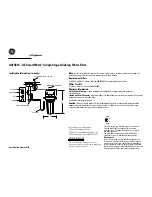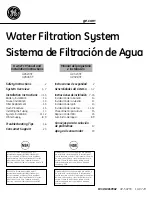
-2-
6. If there are union couplings in
the piping, loosen all three union
couplings close to the tank using
the pipe wrench and adjustable
wrench. Undo completely when
they are loose enough to work by
hand. The pipes will come apart
when the couplings disconnect.
7. Loosen and remove all the bolts
that anchor the pump to the
pump stand using the adjustable
wrench. Remove the pump from
the pump stand of the existing
tank.
(Fig. 4)
If there is not enough
slack in the wiring to let the pump
rest on the floor, either rest it
on a stool or the new pump, or
disconnect the wiring. Don’t let it
hang in the air.
8. Remove the plastic cap on the air
valve on top of the tank. Check
the air charge in the new tank
using the tire pressure gauge.
Adjust the pre-charge pressure
in the tank to be 1-2 psi below
the pressure switch pump cut-in
setting. First look inside the cap to
the pressure switch to determine
the pump cut-in setting. It should
say “20/40” or “30/50” or the
like. The pressure in the tank
should be adjusted to be 2 psi
below the lower pressure of
these two numbers. That is, the
tank pressure should be set at
about 18 psi if the cap indicates a
setting of 20/40, or set at about
28 if the cap indicates a setting
of 30/50.
If this charge is too high, release
some air by pressing down on
the pin inside the air valve. If the
charge is too low, pump it up
using a bicycle tire pump or air
compressor.
Alternatively, you can adjust
the pressure switch to match
the pressure in the tank. See
instructions on the inside of the
pressure switch cap for how to
do this.
9. Place the pump on the pump
stand of the new tank.
(Fig. 5)
Do not insert the bolts yet. (You
will need to move the pump
around to pipe it to the existing
pipes.)
10. Install the new tank.
a. Remove the inlet pipe to the
existing tank.
(Fig. 6)
Either
re-use the existing inlet assembly,
or purchase a tank installation kit,
which should include: a 3/4” x 4”
or so pipe nipple; a 3/4” fpt x 3/4”
fpt x 3/4” fpt pipe tee; and a 3/4”
fpt standard drain/boiler drain
valve.
b. Apply Teflon
®
tape to the
threaded male end of this inlet
pipe which inserts into the tank.
c. Insert this inlet pipe into the
female pipe threaded opening at
the end of the new tank. Tighten
hand tight. Then wrench tight
using the pipe wrench and the
12” adjustable wrench.
(Fig. 7-8)
Make sure that the pipe to the
supply line ends up in a vertical
position pointing up. Tighten
slowly to make sure you do not
over tighten.
(Fig. 8)
Do not
loosen the pipe once tightened. If
you do, it is more likely to leak.
d. Move the existing tank out of the
way. Discard.
e. Move the new tank into position
with the inlet assembly attached.
f. If the two tanks are the same size,
then the piping will match up.
If the two tanks are different sizes,
then the piping for the new tank
probably will not match the old. In
this case, adjust the piping to fit.
If pipes are mismatched by only
a small amount, you can force the
pipes to fit or use nipples that are
longer or shorter to make ends
meet.
g. Match up the union couplings.
Tighten hand tight.
(Fig. 9)
Tighten until wrench tight to seal,
using the 12” adjustable wrench
and the pipe wrench.
(Fig. 10)
h. Insert the bolts for the pump into
place to hold it to the stand. Move
the tank as necessary underneath
the pump to make the holes in
the pump line up with the holes
in the pump stand. Screw on the
nuts to the bolts. Tighten wrench
tight using the adjustable wrench.
(Fig. 11)
11. Examine the plumbing system to
see if you have a pressure relief
valve between the pump and the
tank.
Always be sure
to equip your
well system with a proper Pressure
Relief Valve.
The system shows what the
Pressure Relief Valve should look
like.
(Fig. 12)
If you do have a Pressure Relief
Valve in the system, go on to
Step 12.
If you do not:
a. Remove the boiler drain from the
inlet valve now on the tank. Make
the pipe tee/nipple assembly.
Wrap Teflon
®
tape around one
of the male threaded ends of
the nipple. Insert it in one of the
female threaded openings in the
3/4” fpt x 3/4” fpt x 3/4” fpt
pipe tee. Tighten hand tight, then
wrench tight.
b. Install the pipe tee / nipple
assembly.
(Fig. 13)
Apply Teflon
®
tape to the male thread at the
other end of the nipple (which is
now half inside the pipe tee). Insert
the pipe tee / nipple assembly
in the female threaded opening
on the tank inlet assembly from
which you removed the boiler
drain. Tighten hand tight, then
wrench tight.
A
drip
pan
connected to
an adequate drain must be
installed if leaking and flooding
could cause property damage to
the area adjacent to the appliance
or to lower floors of the structure.
c. Install the pressure relief valve.
Apply Teflon® tape to the male
threaded end of the valve.
Insert the pressure relief valve in
the female threaded opening on
the side of the pipe tee. Tighten
hand tight, then wrench tight.
(Fig. 14)
d. Insert the standard drain in the
female threaded opening of the end
of the pipe pee/nipple/pressure
relief valve assembly. Tighten hand
tight, then wrench tight.
(Fig. 15)
12. Open the ball or gate valve on the
pump feed line.
(Fig. 16)
Open the
ball or gate valve on the supply
line.
4
10
11
12
13
14
15
5
6
7
8
9






























